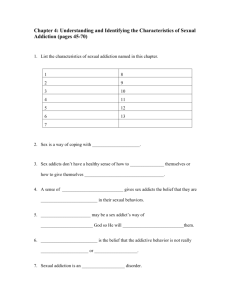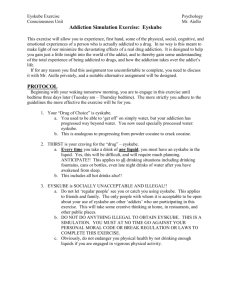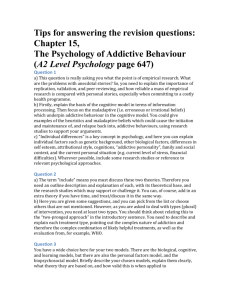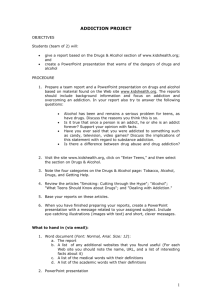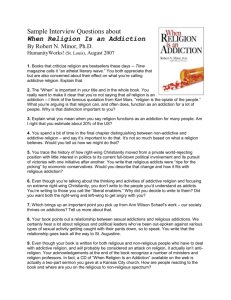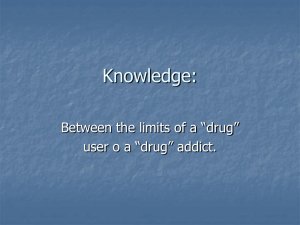ADDICTION —An Introduction - Australian Greek Welfare Society
advertisement
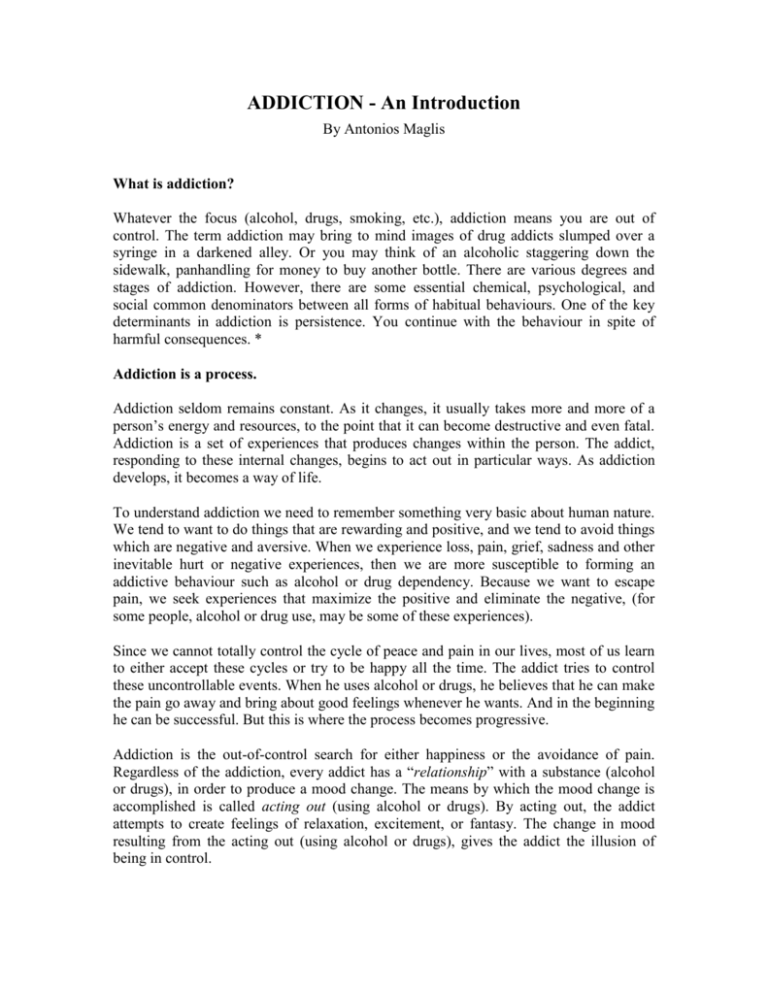
ADDICTION - An Introduction By Antonios Maglis What is addiction? Whatever the focus (alcohol, drugs, smoking, etc.), addiction means you are out of control. The term addiction may bring to mind images of drug addicts slumped over a syringe in a darkened alley. Or you may think of an alcoholic staggering down the sidewalk, panhandling for money to buy another bottle. There are various degrees and stages of addiction. However, there are some essential chemical, psychological, and social common denominators between all forms of habitual behaviours. One of the key determinants in addiction is persistence. You continue with the behaviour in spite of harmful consequences. * Addiction is a process. Addiction seldom remains constant. As it changes, it usually takes more and more of a person’s energy and resources, to the point that it can become destructive and even fatal. Addiction is a set of experiences that produces changes within the person. The addict, responding to these internal changes, begins to act out in particular ways. As addiction develops, it becomes a way of life. To understand addiction we need to remember something very basic about human nature. We tend to want to do things that are rewarding and positive, and we tend to avoid things which are negative and aversive. When we experience loss, pain, grief, sadness and other inevitable hurt or negative experiences, then we are more susceptible to forming an addictive behaviour such as alcohol or drug dependency. Because we want to escape pain, we seek experiences that maximize the positive and eliminate the negative, (for some people, alcohol or drug use, may be some of these experiences). Since we cannot totally control the cycle of peace and pain in our lives, most of us learn to either accept these cycles or try to be happy all the time. The addict tries to control these uncontrollable events. When he uses alcohol or drugs, he believes that he can make the pain go away and bring about good feelings whenever he wants. And in the beginning he can be successful. But this is where the process becomes progressive. Addiction is the out-of-control search for either happiness or the avoidance of pain. Regardless of the addiction, every addict has a “relationship” with a substance (alcohol or drugs), in order to produce a mood change. The means by which the mood change is accomplished is called acting out (using alcohol or drugs). By acting out, the addict attempts to create feelings of relaxation, excitement, or fantasy. The change in mood resulting from the acting out (using alcohol or drugs), gives the addict the illusion of being in control. The process continues as the addict attempts to make sense out of life. He believes he is being fulfilled by his behaviour (using alcohol or drugs). Because the activity gains access to rewarding feelings, or at least helps escape pain and hurt, the process of using alcohol or drugs is reinforced. As the addictive cycle continues, the acting out behaviour (using alcohol or drugs), is also a way to escape the shame and guilt created by knowing that he (the addict), is out of control. ** Addiction has a seductive nature. As the addict continues to engage in his behaviour, a very seductive thing happens. The addict begins to believe that alcohol or drugs can nurture him. This happens because the acting out, whether relaxing, thrill seeking, or fantasy, allows the addict to get temporary relief from the pain and pressure of life. There is some short-term gain in having access to this mood-altering experience (using alcohol or drugs). We all have avoided dealing with some of life’s unpleasant activities. The difference is that an addiction becomes a lifestyle in which the addict loses control and becomes enmeshed into a habitual avoidance of reality. The addict tries to nurture himself by avoiding responsibility and denying reality. Gradually, seductively, the addict begins to depend on the addictive process for a sense of nurturing. He looks to the mood change to define who he is. The acting out helps avoid the negative feelings. Life takes on a singular focus- the pursuit of the addiction. This is part of the insanity of the addictive process. Normally, people get emotional needs met by reaching out to other people. The addict tends to withdraw and isolate himself. As this process continues, the addict feels even more hopeless about his ability to ever have a meaningful relationship with anyone outside of his addictive experience. The addict hurts, he is lonely and isolated and turns to his addiction for relief. This subsequent mood change will then give the illusion that a need has been met; but the addict has been nurtured by alcohol or drugs, not by the compassion of a loved one. The problem with this aspect of the addictive process is that the feelings of detachment and separation will only drive the addict into greater reliance on their mood-altering experience (more alcohol or drug use). It turns into a vicious cycle, and often leads to calamity and self-destruction. Another reason the addict becomes separated from people is the reliability of chemical substances. If you take a drug, you are practically guaranteed a mood change. For the addict, alcohol or drugs can be trusted to provide a change in mood. People are not so predictable; sometimes they let you down or are not there when you need them. As a result, the addict learns to trust his addiction more than people. By acting out (alcohol or drug use), the addict experiences a sense of control. This helps to counteract the feelings of powerlessness deep within. The promise of power in the face of helplessness is the nature of addiction. The addict begins to believe false and empty promises: the promise of relief, of emotional security, the false sense of fulfilment, and of intimacy with the world. Certainly there is a biochemical basis to addictions. Enkephalins, and related compounds called endorphins, are pain-killing molecules that are produced naturally in the brain. The strong mood-altering chemicals are structurally similar to opiate drugs and appear to behave in similar ways. The brain can actually produce its own opiates. Individuals can change their brain chemistry by participating in certain mood-altering activities, as well as through ingesting intoxicating substances (legal or illegal drugs). Leaping from an airplane and then free-falling from an altitude of 13,000 feet will produce a chemical change in the brain that is quite similar to taking a hit of cocaine. While interesting and helpful, the chemical explanations for addiction are still not sufficient in and of themselves. Addictive behaviour has its roots in every aspect of our being. That is why it is so seductive and compelling. Addiction is evident when one becomes progressively unable to control the beginning or end of a need-fulfilling activity like alcohol or drug use. Compulsive behaviour is best understood as an individual’s selfdefeating adjustment to his environment. It represents a habitual style of coping. But it is a style of coping behaviour from which there is no escape. However, there is hope, even though the pathway to recovery is narrow and long. It is possible to regain control. *** Addictive thinking. The feelings and actions of the addict are affected by certain beliefs about events and situations. Many of those beliefs may not be true, but they are held to, tenaciously, because the addict knows no other way. On a logical level, addicts know that alcohol or drugs cannot bring emotional fulfilment. But addiction does not follow usual logic. It does make sense, however, when viewed through the eyes of the addicts. Emotional intimacy, whether positive or negative, is experiential and is not a product of conscious, logical thought. Emotional needs are often urgent and compulsive. The addict tries to satisfy his urgently felt need as quickly as possible, even when it is not in his best interests. The addict’s thinking says to him that the alcohol or drug use will take his mind off his problems. He wants the stimulation, so he gives in to the emotional logic that says the mood-altering experience of alcohol or drug use will make him feel better. He is doing something to make himself feel good, and he is doing it now. How could the logic be better? That is why addictions can be cunning, baffling, and powerful. A person’s belief system will influence whether he will continue to return to an experience that is progressively damaging. Even after an addictive attachment has developed, a person can choose to change his belief system to either support or reject the addiction. Thus, understanding our beliefs, both true and false, is a vital component in understanding the causes and providing relief from the addiction. **** Stages of addiction. There are three stages to the addiction process. The first involves internal changes. The personality begins to change as a result of the intoxicating experiences. The second stage involves changes in lifestyle. Now it is more obvious to those around the addict because he is behaving in ways that are unusual and counterproductive. The final stage occurs when the addict becomes out of control. Nothing matters but getting more of the mood- altering experience (alcohol or drug use). Pleasure is gone and life is only a survival ordeal. Here are some of the details of each stage. ***** Stage One. For the addict, a life experience that produces a pleasurable mood change (alcohol or drug use), can give the illusion of control and comfort. This can be the start of the addictive journey. The initial experiences of alcohol or drug use are usually quite intoxicating. This euphoric experience teaches the prospective addict that one’s feelings can change through a relationship with an object or event (alcohol or drug use). This intense feeling, unfortunately, gets mistaken for intimacy, nurturance, and a sense of personal power. Addiction begins when a person repeatedly seeks the illusion of relief to avoid unpleasant feelings or situations. Emotional needs are met by seeking nurturing through avoidance. The person wants to avoid the pain, so feels the need to soothe the pain. This urge leads to acting out (alcohol or drug use), and the resulting mood change. The person starts to feel better. But pretty quickly there is the pain resulting from acting out. Now the person has experienced pain again, so feels the need to act out (more alcohol or drug use) again, does act out, feels pain and remorse, and the cycle goes on and on. At this point the addiction starts to create the very thing the person is trying to avoid—pain. However, in creating pain, the process also creates a need for the continuation of the addictive relationship. The addict seeks refuge from the pain of addiction by moving further into the addiction. This cycle causes an emotional craving that results in mental preoccupation. The more ingrained the cycle, the greater the preoccupation and dependency. Eventually, the person forms a dependent relationship with his own addictive personality. Stage Two. The acting out (alcohol or drug use), is a sign that the person is out of control on an internal level. In Stage Two, the person becomes out of control on a behavioural level. The episodes of being behaviourally out of control become more frequent. The addict becomes more preoccupied with the object or event (alcohol or drug use), that can temporarily stop the pain. In this stage others start to notice something is wrong. The presence of an addictive personality becomes obvious to family and friends. The addict starts to act out his belief system in a ritualistic manner and his behaviour is more out of control. He becomes dependent on the addictive personality, mot just the mood change or the object or event (alcohol or drug use). The addictive belief system develops into a lifestyle. In this stage the person uses addictive logic to guide him. Here are some of the ways this stage shows itself: The addict lies when it would be easier to tell the truth. The person blames others, knowing it is not true. Behaviour becomes ritualised. The person withdraws from others. Because the addict must make emotional sense to himself of the inappropriate behaviour, he turns to denial, repression, lies, rationalizations, and other defences to cope with what is happening. When the addict acts out, he must withdraw into his addictive personality to receive support. This action causes him to become even more isolated from others around him. The loneliness becomes another signal to act out (more alcohol or drugs). This vicious cycle serves to strengthen the addictive process. The behaviour becomes more ritualised. For the addict, a ritual brings a form of comfort because it is predictable. Addictive rituals make the addict feel worse about himself. Addictive rituals destroy relationships. Addictive rituals cause shame. In Stage Two, the addict surrenders to the immense power of addiction. As the addict becomes more controlled by the process, those people around the addict sense his emotional withdrawal and react to it. This is the start of people problems, as the addict manipulates people and treats them as objects. The next thing that happens is for the people around the addict to label him as irresponsible, troubled, tense, crazy, or strange. Stage two, includes the development of tolerance (not able to escape the pain). Because of this tolerance and increased anger and pain, the addict will start to act out (alcohol or drug use), more frequently and in more dangerous ways. This constant attempt to keep ahead of the tolerance level, combined with the internal emotional struggle, is a tremendous energy drain. Like any progressive illness, the addiction will take more of the addict’s energy and attention, limiting his ability to live a “normal” life. Stage Three. By Stage Three, the addictive personality is in total control. At this point, acting out (alcohol or drug use), no longer produces much ecstasy. Preoccupation, rituals, and acting out will still produce a mood change, but the pain never goes away. The magical intoxication begins to break down. The addict is unable to break the addictive cycle. His lifestyle is devoted to addictive ritual. The addict is preoccupied with those things that will help him maintain the addictive lifestyle. Nothing else matters. Emotions break down. Paranoia, depression, anger, rage, guilt, shame, loneliness, and hopelessness anxiety, panic attacks, hysteria and a feeling that everyone has turned against him take over. Suicide is a common consideration at this stage. Environmental problems also abound. Work is endangered, marriages are threatened or ended, health, financial, and legal problems emerge. Addicts cannot break the addictive process and will remain stuck in Stage Three, unless there is some form of intervention. Only strong, professional, and appropriate intervention has a chance of making a difference. ****** Information in this pamphlet is taken from: * “When Good Things Become Addictions”, Dr. Grant Martin ** ”The Freedom We Crave”, William Lenters *** “The Voyage of the Dawn Treader “, C.S. Lewis **** “The Twelve Steps, Friends in Recovery ***** “God, Help Me Stop”, Claire W. ****** “Kids & Drugs—A Realistic Guide”, Paula Goodyer FOR MORE INFORMATION CONTACT: Australian Greek Welfare Society (Vic.) Tel. 9388 9998 Alcohol & Drug Information Service (Vic.) Tel. 9416 1818 & 1800 136 385 Australian Drug Foundation (Vic.) Tel. 9278 8100 & 1800 069 700 Centre for Adolescent Health (Vic.) Tel. 9345 7922 Turning Point Drug & Alcohol Centre (Vic.) Tel. 9254 8061 Families Anonymous (Vic.) Tel. 9889 8112 Narcotics Anonymous (Vic.) Tel. 9417 6472 Families & Friends for Drug Law Reform (Vic.) Tel. 9366 8002


